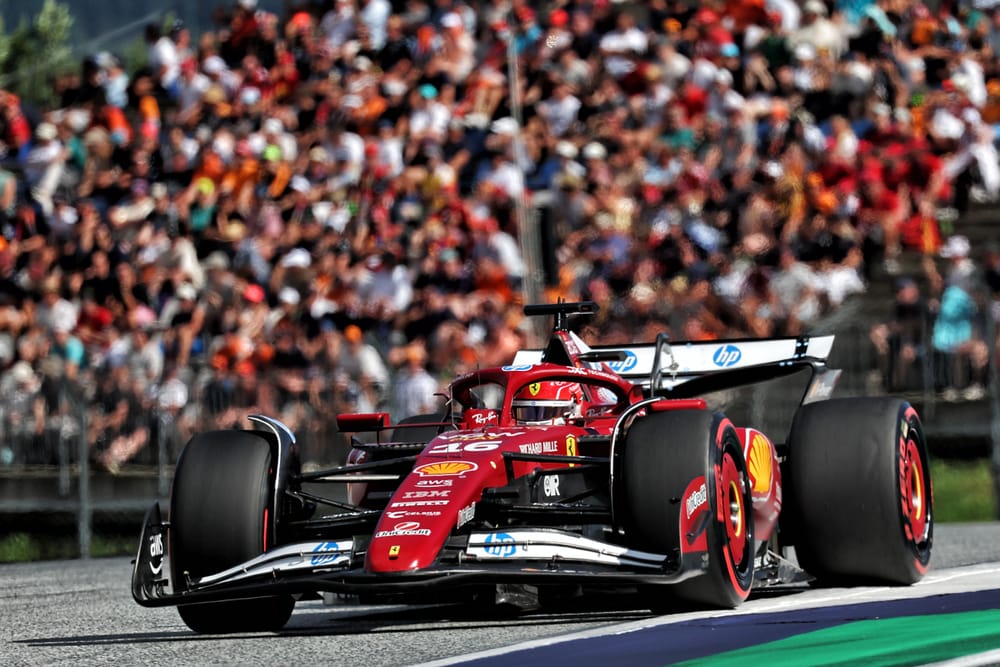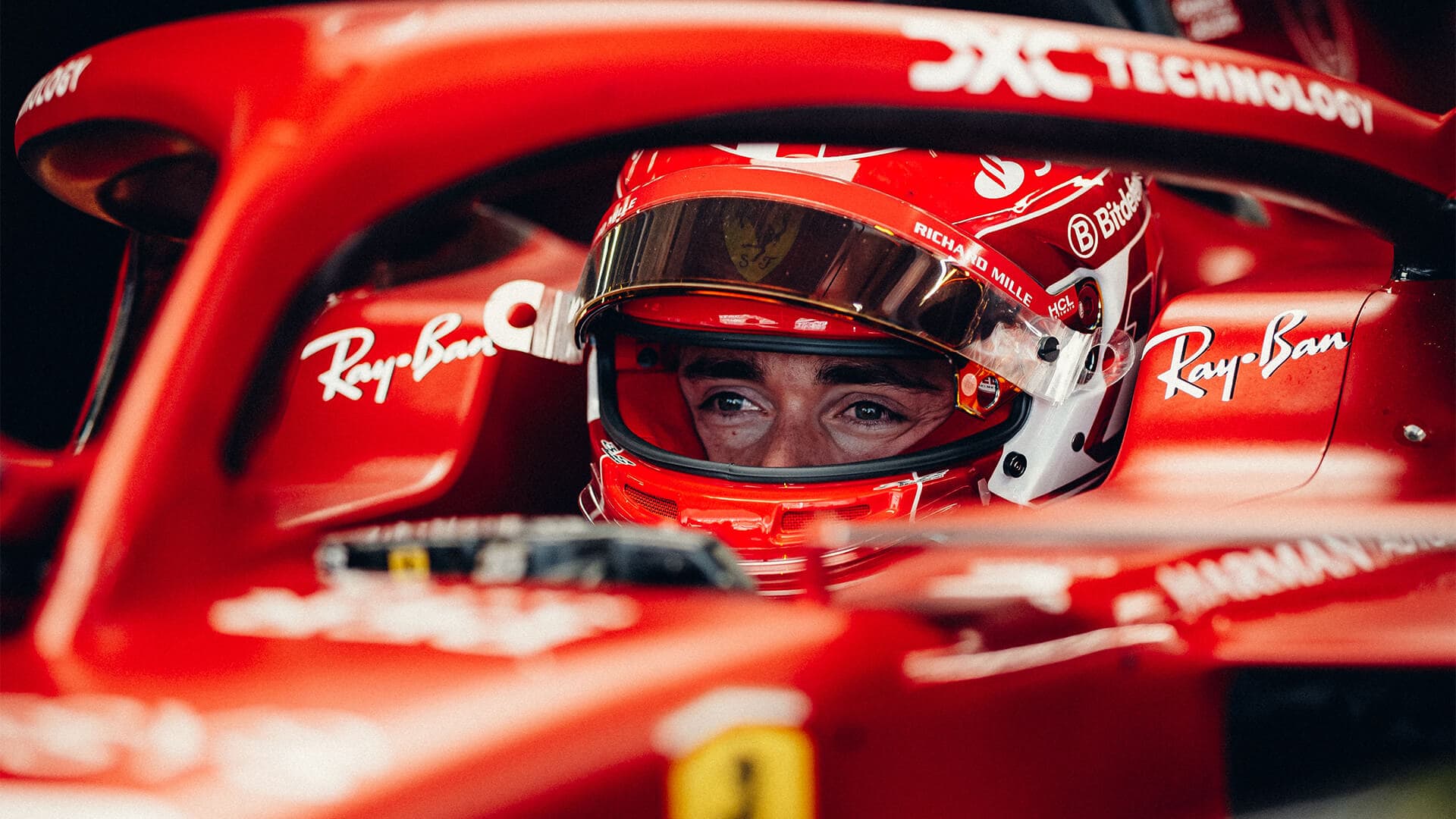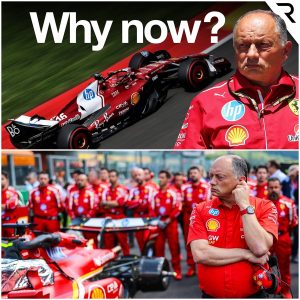The 2025 Formula 1 season has been a roller-coaster for Scuderia Ferrari. With some highs and numerous lows, the team has struggled to close the gap to the dominant Red Bull.
However, after the introduction of their second-phase upgrade, Ferrari seems to have regained some ground, securing its position as McLaren’s closest rival in the constructor standings.
Despite this progress, Ferrari driver Charles Leclerc remains cautious about their ability to challenge for victories in the second half of the season.

Ferrari’s Upgraded Package
At the Belgian Grand Prix, Ferrari introduced a new suspension system featuring a revised geometry and a modified central damper. These changes are designed to enhance platform control and allow the team to run the car at lower ride heights, which had initially been part of the car’s design before adjustments were made following the plankware disqualification of Lewis Hamilton in China. This modification is critical in addressing the limitations Ferrari faced earlier in the season when car setup and ride height compromises prevented optimal performance.
In addition to the suspension update, Ferrari also implemented a floor upgrade at the Austrian Grand Prix. These enhancements are viewed as Ferrari’s attempt to recover from earlier setbacks and elevate their competitiveness for the second half of 2025. The modifications were seen as a step forward in a season that, despite improvements, still leaves Ferrari with a lot of ground to cover in the quest for race wins.

Charles Leclerc’s Reaction: Cautiously Optimistic
After securing his fifth podium of the season at Spa, Leclerc acknowledged the improvements brought by the upgrade but was quick to temper expectations. During qualifying at Spa, he was pleasantly surprised by the car’s performance, finding himself ahead of Max Verstappen and only 0.3 seconds behind Lando Norris’ pole position time. However, Leclerc stressed the fine margins of the improvements, stating, “It was a step in the right direction, but it was very fine differences over a whole lap.”
The upgrade, according to speculation, might only offer a small gain of around a tenth of a second per lap, but it is the flexibility that it provides Ferrari in terms of setup adjustments that could make the real difference. Leclerc noted that the improved suspension setup allowed him to push harder, producing the kind of performances Ferrari and its drivers have been yearning for. However, despite the improved performance, Leclerc also made it clear that Ferrari’s current position is still far from where they need to be if they are to consistently challenge the likes of McLaren, Red Bull, and Mercedes. “We are all aware that this is not enough,” he admitted.
While Ferrari is now comfortably settled in second place in the constructor standings, it still struggles to keep up with the top teams. The new suspension is only a part of the puzzle, and Ferrari’s rivals continue to bring new upgrades, which keeps moving the goalposts for the Scuderia.

The Ongoing Struggles of Lewis Hamilton
Leclerc’s teammate, Lewis Hamilton, has had a less consistent experience with the upgrades. Although he was able to make significant progress in the Belgian Grand Prix, Hamilton’s qualifying performance left much to be desired. After a shock Q1 elimination in both the Sprint and Grand Prix qualifying sessions, Hamilton’s race was compromised. He blamed his difficulties on a new braking system introduced by Ferrari, which he struggled to adjust to over the weekend.
Hamilton’s experience underscores the challenge of fine-tuning a car in the middle of a season. Ferrari has been working on modifications to both its suspension and braking systems, but these changes have created some teething problems. Hamilton’s issues were compounded by weather conditions and contrasting race circumstances compared to Leclerc, which made it difficult to assess the full benefit of the upgrade package.
Hamilton was quick to point out that, despite the issues, Ferrari’s progress is evident. “The tricky spa weekend would be easy to put behind me,” Hamilton said. “I actually feel confident about our progress.” Before Spa, Hamilton had outqualified Leclerc in three of the past four races, and his form in the wet conditions at Silverstone showed his potential in a well-balanced car. However, his frustration at Spa, where qualifying mistakes cost him valuable points, shows just how much Ferrari still needs to improve.
Behind the Scenes: Development and Team Reshuffles
Ferrari’s efforts have not only been focused on track performance. The team has also been working behind the scenes, with significant changes in its engineering team. Hamilton, for example, has been vocal about changes in Ferrari’s structure, including the appointment of a new performance engineer to work with him. Although Ferrari has not disclosed the identity of this new engineer, it’s believed that this person was promoted from another role within the team and has worked with Hamilton in the past, likely during their time together at Mercedes.
This reshuffling is indicative of Ferrari’s ongoing efforts to optimize its operations, but it also highlights some of the challenges the team faces in implementing change mid-season. Hamilton has acknowledged the steep learning curve that comes with switching engineers mid-year, and the changes to the braking system have added another layer of complexity.
Hamilton’s critical feedback following the Belgian Grand Prix also reveals that, while the new upgrades show promise, they are far from perfect. “The rear end of the car still isn’t where it needs to be,” he stated. Yet, despite these setbacks, Hamilton remains optimistic, believing that the issues they are facing are part of a longer-term development plan.
Ferrari’s Long-Term Aspirations: Crunch Time for Hamilton
For Hamilton, the pressure is mounting. At 40 years old, the clock is ticking, and he is fully aware that he has limited seasons left in Formula 1. He is determined not to repeat the experiences of past Ferrari champions like Fernando Alonso and Sebastian Vettel, both of whom spent significant time at Ferrari but left without winning a championship despite numerous race victories. Hamilton has been actively involved in discussions with Ferrari’s leadership, sharing his insights on car development and team structure.
The team’s upcoming decisions are crucial for Hamilton, who is aiming to secure at least one title during his time at Ferrari. His extensive experience in the sport, coupled with his ongoing development work, means that he could be the catalyst for Ferrari’s rise if the team can fine-tune its approach. But this is now “crunch time,” as Hamilton himself put it. His chances of success with Ferrari rest on how well the team can harness the full potential of its upgrades, improve consistency, and remain competitive with the other teams vying for supremacy in 2025.
Conclusion: Ferrari’s Path Forward
Ferrari’s recent upgrades show promise, but the team still has a long way to go if it hopes to challenge for victories in the second half of the 2025 season. While Charles Leclerc is starting to find more consistency, and Lewis Hamilton remains confident about the team’s progress, Ferrari’s position in the constructor standings still highlights the gap between them and the frontrunners.
The team’s cautious optimism is warranted, and the long-term focus on developing the 2026 car suggests that Ferrari is thinking beyond this season. However, the road to winning races—and ultimately a championship—remains challenging. Ferrari will need to continue to refine its upgrades, improve its car’s consistency, and ensure that its drivers can extract the maximum performance from it if they want to close the gap to the dominant teams like McLaren and Red Bull.
As we head into the second half of the season, Ferrari’s challenge is clear: they must consistently evolve, push their car to its limits, and take full advantage of every opportunity in their bid for a return to the top step of the podium.
Full Video:





